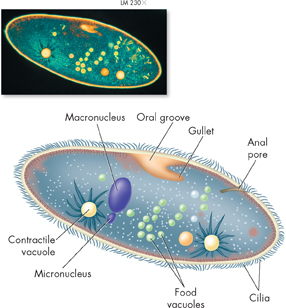Heterotrophic Protists
 How do heterotrophic protists obtain food?
How do heterotrophic protists obtain food?
Many protists are heterotrophs: They obtain food from other living organisms.  Some heterotrophic protists engulf and digest their food, while others live by absorbing molecules from the environment.
Some heterotrophic protists engulf and digest their food, while others live by absorbing molecules from the environment.
Amoebas Amoebas can capture and digest their food, surrounding a cell or particle and then taking it inside themselves to form a food vacuole. A food vacuole is a small cavity in the cytoplasm that temporarily stores food. Once inside the cell, the material is digested rapidly, and the nutrients are passed along to the rest of the cell. Indigestible waste materials remain inside the vacuole until the vacuole releases them outside the cell.
Ciliates Paramecium and other ciliates use their cilia to sweep food particles into the gullet, an indentation in one side of the organism, as shown in Figure 21–9. The particles are trapped in the gullet and forced into food vacuoles that form at its base. The food vacuoles pinch off into the cytoplasm and eventually fuse with lysosomes, which contain digestive enzymes. Waste materials are emptied into the environment when the food vacuole fuses with a region of the cell membrane called the anal pore.
BUILD Vocabulary
MULTIPLE MEANINGS The name Amoeba refers to a particular genus of protists, but it is also used generically (in lowercase and without italicization) to mean “any protists that move using pseudopods,” including the unicellular form of slime molds.

FIGURE 21–9 Feeding Structures of Paramecium Cilia lining the gullet move food to the organism's interior. There, the food particles are engulfed, forming food vacuoles.
dQuick Lab
GUIDED INQUIRY
How Does a Paramecium Eat?

Use separate dropper pipettes to place a drop of paramecium culture and a drop of Chlorella culture next to each other on a microscope slide.
Use a toothpick to transfer a few granules of carmine dye to the drops on the slide. Add a coverslip so that the two drops mix.
Place the slide on the microscope stage and use the low-power objective to locate several paramecia.
Use the high-power objective to observe the contents and behavior of the paramecia.
Observe Where did the Chlorella cells and carmine dye granules accumulate?
Infer How do you think this accumulation of cells and dye granules occurs?
Form a Hypothesis What process in the paramecia do you think resulted in this change?
Analyze and Conclude
Table of Contents
- Formulas and Equations
- Applying Formulas and Equations
- Mean, Median, and Mode
- Estimation
- Using Measurements in Calculations
- Effects of Measurement Errors
- Accuracy
- Precision
- Comparing Accuracy and Precision
- Significant Figures
- Calculating With Significant Figures
- Scientific Notation
- Calculating With Scientific Notation
- Dimensional Analysis
- Applying Dimensional Analysis




